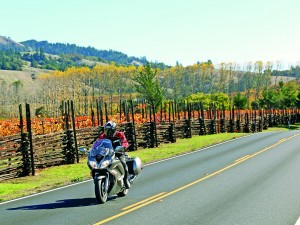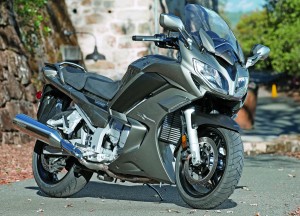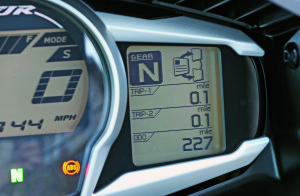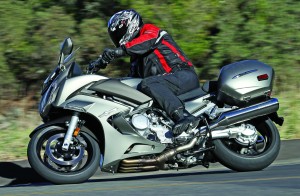When we broke the news that an updated Yamaha FJR1300 was on the way for 2013 in the December 2012 issue, the reader reaction was the usual mix of praise and grousing (mostly that the bike hasn’t been changed enough). What surprised us, though, is that almost everyone who wrote qualified their opinions with the hundreds of thousands of miles they had put on a series of FJR1300s since its introduction for 2003. That kind of mileage and loyalty suggest that the bike has been a satisfying performer at its main job, and that changes to its basic platform are unnecessary.

To that end, the 2013 FJR1300’s stout twin-spar aluminum chassis is the same, and its powerful liquid-cooled, 1,298cc in-line four has only been refined for lower frictional losses, smoother shifting and slightly more power. New piston rings, coated sleeveless cylinders, throttle bodies, ignition and a less restrictive exhaust contribute to a claimed 3 horsepower and 3 lb-ft of torque increase, which was borne out on the Jett Tuning dyno when our 2013 FJR made 129.7 horsepower at 8,000 rpm and 91.2 lb-ft at 7,100 at the rear wheel. Most importantly, more than 75 lb-ft are on tap from 3,500 rpm to redline at 9,000. Two Drive modes are available now—Sport, for quicker throttle response, and Touring, for a more leisurely feel. Both output 100 percent of the bike’s power—only the delivery is different. In Sport, the engine definitely feels peppier ridden back-to-back with a 2012 model…if an engine that already pulls like a bullet train can be described as peppier.
Some of that brighter throttle response is attributable to the bike’s new throttle-by-wire system which, unlike some other TBW systems, works smoothly from just off idle and throughout the powerband. It also enabled the addition of electronic cruise control, which sets, holds and changes speeds quite precisely in gears 3-5, and traction control (that can be switched off), alongside the existing anti-lock brakes. A new machining method for the transmission gears gives the 5-speed gearbox a slicker feel. Combined with the useful electronic enhancements, overall the drivetrain feels like it spent a refreshing week at a health spa.

Virtually all-new bodywork includes a new electric windscreen that raises and lowers twice as fast and remains in position when you shut off the ignition. Its new shape also reduces noise in the low position and turbulence in both high and low but, for highway speeds, the 4.5-inch taller, 3-inch wider accessory screen should cut down on noise. Slick panels in the lowers can be expanded by 20mm to help direct air around the rider; combined with the airflow fixes from 2008, I found the amount of felt engine heat to be tolerable on a warm day and quite welcome on a cold one. A slightly narrower height-adjustable seat with nice new covers helps you get your feet down more easily at stops and, like the rest of the bike’s ergonomics, is very comfortable for long rides.
Some of the nicest updates are to the suspension and tires. The bike wears Bridgestone’s latest BT-023 radials with a special “F” designation for the FJR; they and the replacement version we’ve tested here and in Japan have proven an excellent choice for it. The 2013 model steers more quickly and transitions more smoothly, putting its handling speed nicely between the (by comparison) darty BMW K 1600 GT and somewhat sluggish Kawasaki Concours 14. Two-up and fully loaded, an aggressive rider may sometimes wish for more cornering clearance, but solo you really have to work to touch anything down. Up front, a new, fully adjustable fork design with damping adjustments in just the right leg shaves five pounds off the bike’s wet weight, and the rear shock with its two-position preload and adjustable rebound damping has a stiffer spring and new damping settings. Overall, the combo is more compliant and comfortable yet retains all of the control of the former setup.
Modernized instrumentation and switchgear really enhance the 2013 FJR1300 riding experience, with a customizable trip computer display and electronic control for the heated grips. Load capacity is up to a generous 448 pounds, and a magnetic tankbag can be fitted to the large 6.6-gallon metal tank. We wish Yamaha had also upgraded the bike’s 30-liter saddlebags, which come standard with liners but remain a little small. Fortunately there’s a luggage rack and new 50-liter accessory trunk this year that holds two helmets.
Ample power, comfort, capacity and improved handling along with lots of handy new features make the 2013 Yamaha FJR1300 even more ready for the big leagues, and big miles. Can’t wait for the shootout….
2013 Yamaha FJR1300
Website: yamaha-motor.com
Base Price: $15,890
Engine Type: Liquid-cooled, transverse in-line four, DOHC, 4 valves per cyl.
Bore x Stroke: 79.0 x 66.2mm
Displacement: 1,298cc
Transmission: 5-speed, hydraulically actuated wet clutch
Final Drive: Shaft 2.698:1
Wheelbase: 60.8 in.
Rake/Trail: 26.0 degrees/4.3 in.
Seat Height: 31.6/32.5
Wet Weight: 663 lbs.
Fuel Capacity: 6.6 gals.
MPG: 86 PON min. (high/avg/low) 40.6/39.6/38.7
(This article Rider Test: 2013 Yamaha FJR1300 was published in the February 2013 issue of Rider magazine.)
 |
 |









I want one!
i have an 2010 model and love it now the 2013 one has come out i want one
I like it a lot. I recently owned a Concours14 since new.(decent bike) I replaced that with a 2010 FJR. I like the 2010 FJR so much I’m already thinking of an upgrade to the 2013 FJR. I even like the color.
At least you didnt drop it into the water
I’ve owned two FJR’s, the Generation I, 2005 and currently a Generation II, 2007. I put 23K on the ’05 and 42K on the ’07. I like them both. For me the Gen II is noticeably more refined. Yamaha engineers made a lot of little tweaks to improve rideability. They improved the cooling and airflow management, they tweaked the gearing to lower the rpm’s by about 500 in top gear. They changed the mirrors and redesigned the fairing so I could bolt on sliders without drilling holes in the fairing. There were other little changes as well; they all added up to an even better machine than the original. It sounds like Yamaha has done it again with the 2013. I keep looking for a better Sport Tourer for the money and wind up buying another FJR. There must be a lesson in that!
I have a 2007 FJR, I have just done over 4000 km from Johannesburg down to the Cape along the garden route from PE down to Hermanus and through Gordon’sbay to Tableview, We took a drive along Chapman’s Peak and back to Tableview. From Tableview we traveled along the Route 62 on our way back. I had two panniers and a topbox on the bike and I managed to get an average of 18.5 km to a litre.
I think the FJR is a winner as it is and does not need tampering with the basic construction.The cente of gravity makes the handling a pleasure throuhg the bends. The adjustable windshield is a pleasure in the Cape winds and rain. I did this trip from the 27th of December to the 5th of January. I had a look at 2013 FJR on the internet and it looks very good.
The FJR is not only a good looking bike, once you are on the road you will appreciate its qualities like performance, roadholding, fuel consumption and comfort and it does not stand back for any other sports tourer.
The only part that Yamaha can improve on is the promoting of the FJR.
In a nutshell, value for money you will not beat.
I own an 05 FJR and have put over 100,000 kms on it. Yamaha has made these bikes rock solid never a problem and still a joy to get on and ride every day.
After 50 years and 35+ machines I finally landed on a Gen 1 FJR a few years ago and love the machine. Added a few tweaks on the seat and a cruise control and the bike does such a great job I can’t let it go. Every time I get the itch to move on I run the mental checklist against what I already have and the FJR so far has won every time. If I ever do move from the Gen 1 it may very well be to the 2013…………..
Bought a 2003 FJR in September 2002. Put 80,000 km. on that bike. In 2010 I traded the FJR on a new Goldwing – my sweetie and I do a lot of touring and I thought the Wing would make the riding experience better -WRONG!! When I saw the 2013 FJR, it was love all over again. So, here I am waiting on the Delivery of my brand spanking new FJR (it’s currently on a slow boat from Japan).
En agosto de 2009 estrené mi FJR AS, diseño, potencia, estabilidad, caja secuencial precisa, comodidad total en viajes, la mejor relación calidad/precio en la gama; es la reina.. por Internet , la 2013 tienta por control velocidad crucero y tracción (algo que Yamaha debió ofrecer antes).
I bought a 2012 and wish I had waited. They announced the release about two months after my purchase. I really wish I had cruise. Not to mention upgraded instrumentation.
Come on Yamaha release an upgrade cruise control.
In a couple years maybe I’ll upgrade but maybe I’ll switch over to the new triumph. That’s a hell of a touring machine.
I Love the new FJR and the color….just wish you could get it with the gray or silver wheels instead of the black….wish Yamaha would offer just a few color options instead of just one?????
haven’t riden in ten years.I have been looking for over a year for a sport touring bike from bmw,kawa,honda,etc.Moving forward on the FJR ES.Cant wait.
Note: The picture stating that the seat in the 2013 is slightly narrower, is actually not the stock seat but of an optional accessory seat called the “comfort seat” that costs an additional $375.
You are correct – than you for point it out. The picture was of the accessory seat. To avoid confusion, we have removed the image.
Thank you for taking the time to make the correction.
How long does it take before the side panniers to arrive after you have picked up your bike. I live in Adelaide Sth Australia
Bought a new 2014 FJR back in 2014. Undoubtedly the most boring bike I’ve ever owned. I rode it a little the first year or two, but mostly it just sits gathering dust. I’ve owned over 30 bikes in my life. The FJR sits at the bottom of my list.